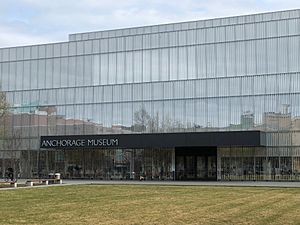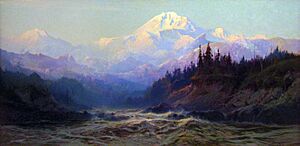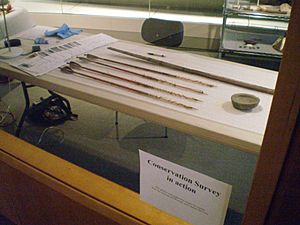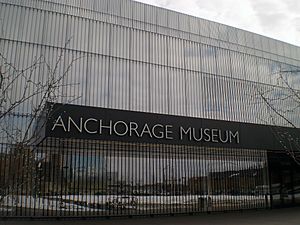Anchorage Museum facts for kids

Main entrance to Anchorage Museum
|
|
| Established | July 18, 1968 |
|---|---|
| Location | Anchorage, Alaska |
| Architect | Mitchell/Giurgola Architects |
The Anchorage Museum is a fantastic place in Anchorage, Alaska! It's a big museum that explores the art, history, and science of Alaska. You can learn all about the land, the people, and amazing stories from the past. The museum has many permanent displays and exciting new exhibits that change often.
Contents
Museum History: How It Grew
The Anchorage Museum first opened its doors on July 18, 1968. It started in a building about the size of a large house, around 1,000 square meters. Back then, it had 60 paintings and 2,500 historical items. Only two people worked there!
The museum has grown a lot since then. It expanded three times, with the latest big change happening in 2010. Now, it's a huge space, about 16,000 square meters. The collection has grown to 25,000 objects and 500,000 old photographs. More than 50 people work at the museum today.
Since 1992, the museum has also been home to the Smithsonian Institution's Arctic Studies Center. This center helps the museum with research, education, and special exhibits.
What You Can Do at the Museum
The Anchorage Museum is a very popular spot in Alaska. Over 180,000 people visit each year, coming from Alaska and all over the world. It's a key cultural center for the community. The museum is often named one of Alaska's top ten visitor attractions.
Every year, the museum hosts 16 to 20 different exhibitions. These are supported by many educational programs and fun activities. For example, in 2006, over 20,000 students and nearly 48,000 adults took part in these learning programs.
Explore Permanent Exhibits
The museum has several amazing permanent exhibits you can always see:
- Alaska History Gallery: Learn about Alaska's past.
- Alaska Art Galleries: See beautiful art from the region.
- Imaginarium Discovery Center: This is a science area where you can explore and discover.
- Smithsonian Arctic Studies Center: Here, you can see real Alaska Native artifacts. These items are on a long-term loan from the Smithsonian Institution.
Research and Learning Resources
The museum has a special library and archives. Publishers, scholars, and researchers often use these resources for information and images. Students and the public can also access books from the library through online interlibrary loan.
The Smithsonian Institution's Arctic Studies Center also runs public programs. They do research to help people understand northern cultures and environments better. They also create exhibitions and offer training for museum staff across Alaska.
Sharing Across Alaska
The museum helps people all over Alaska learn and explore. They organize programs and exhibitions in Anchorage. They also send traveling exhibitions to other towns across the state. For example, exhibits have been shared in places like Unalaska, Bethel, Homer, and Juneau.
The museum also gives advice to other museums and cultural centers in Alaska. They help with things like managing collections, setting up exhibits, and preserving historical items.
Amazing Collections to See
The Anchorage Museum has a huge area, over 3,700 square meters, dedicated to its permanent collection. This collection focuses on Alaska's history, art from the North, and the study of different cultures.
Alaska History Gallery

This gallery tells the story of Alaska's rich history. It covers everything from the animals that first lived there to the early people who migrated to the area. You can also learn about modern Alaska. The Alaska Gallery shows more than 1,000 objects. It's one of the most complete displays of Alaskan history and cultures.
You'll see full-size and miniature scenes that show how Alaska Native peoples lived. You can also learn about Russian explorers, the exciting gold rush era, World War II, and when Alaska became a state in 1959.
Art of the North Gallery
The museum's permanent art collection shows a wide range of art from Alaska and the Arctic region. Seven galleries on the ground floor are filled with this collection. You can see beautiful landscape paintings and drawings from early European trips to Alaska. There are also works by modern artists. One entire gallery is dedicated to paintings by Sydney Laurence, who is perhaps Alaska's most famous artist.
Special Exhibitions and Programs
The museum hosts many different kinds of exhibitions. These include shows where artists compete, exhibits that explain topics in a fun way, and traveling shows from other museums. The museum also offers many exhibits and programs that teach Alaskans about the art, culture, history, and science of other places.
In recent years, the museum has shown exhibits like "Wrapped in Pride: Ghanaian Kente and African American Identity" and "Tibet: Mountains and Valleys, Castles and Tents." They also had "Woven Treasure: The Coverlets of Norway" and several shows of Korean and Japanese ceramics. The museum also makes sure its Alaska-focused programs include the many different cultures that live in Alaska and the Far North.
Public programs include talks, classes, workshops, films, and tours for schools and the public. They also host special events.
How the Museum Works
The Anchorage Museum is run by the Anchorage Museum Association. This is a private, non-profit group. They work under a long-term agreement with the Municipality of Anchorage. The museum's yearly budget comes from money it earns, fundraising, grants, and funds from the municipality. The Municipality of Anchorage owns the museum building and its collections.
The Anchorage Museum Foundation helps manage the museum's long-term funds. They also oversee big projects like expansions.
Meet the Museum Staff
About 50 full-time staff members work at the museum. They are organized into different teams, like Administration, Collections, Exhibitions, and Learning and Engagement. The Smithsonian's Arctic Studies Center also has an archaeologist and an anthropologist working on site.
The museum also relies on many volunteers. Over 300 volunteers help out as guides, in education, with collections, and in the library.
Museum Facilities
The museum's 16,000 square meters include many galleries. Some are for showing the permanent collection, and others are for changing exhibitions. There's a large open area called an atrium, two classrooms, and an auditorium with 230 seats. These spaces host many programs, classes, and special events.
Behind the scenes, there are workshops for preparing exhibits, storage areas for collections, and workspaces. This includes a special lab for conserving (taking care of) old items.
Museum Expansion
A new part of the museum opened in 2010. This new wing features the Smithsonian Institution's Arctic Studies Center. Through this center, 600 Alaskan Native artifacts have returned to Alaska. These items came from the National Museum of Natural History and the National Museum of the American Indian. They are now on display for a long time.
The expansion also added new galleries for changing exhibitions. The library and archives were made bigger, and visitor services were improved. This includes the Muse restaurant and a gift shop.
The new part of the museum was designed by David Chipperfield Architects Ltd. from London. They created a new entrance and a fresh look for the whole museum. The outside of the building has a very unique design with special glass. This glass was custom-made and has a unique pattern that had never been used before. It was designed to handle Alaska's extreme weather.
Working with Other Countries
The Anchorage Museum is an active member of the University of the Arctic (UArctic). UArctic is an international group that works together in the Arctic region. It includes over 200 universities, colleges, and other groups. They all want to promote education and research in the Arctic.



